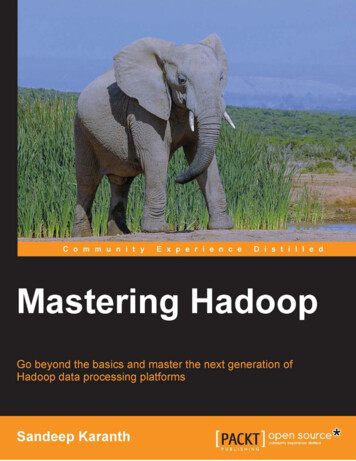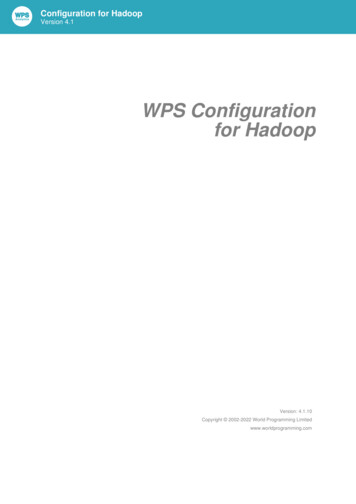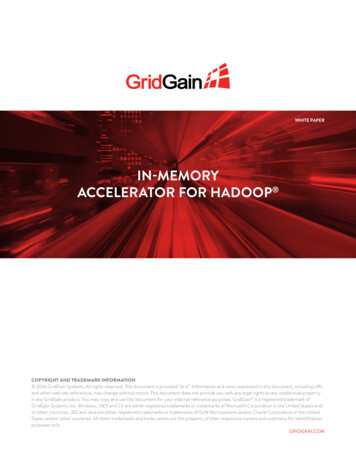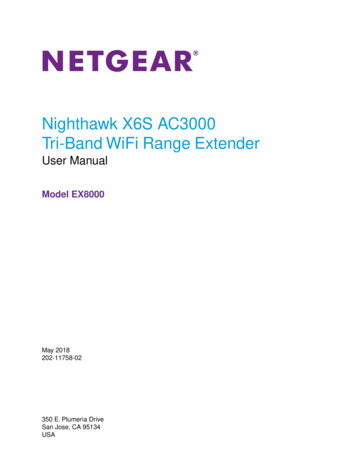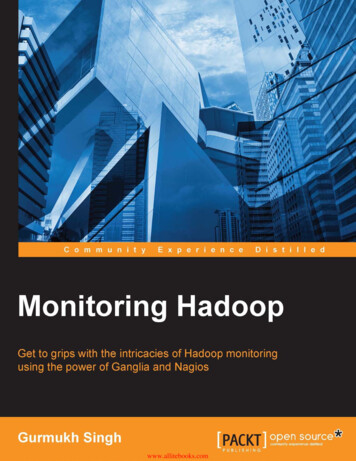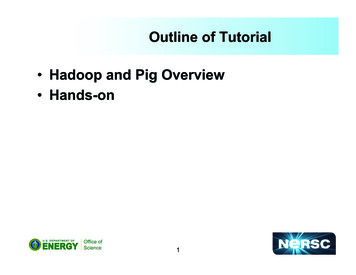
Transcription
Configuration for HadoopVersion 4.4WPS Configurationfor HadoopVersion: 4.4.2(c) 2022 World Programming, an Altair Companywww.worldprogramming.com
Configuration for HadoopVersion 4.4ContentsIntroduction. 4Prerequisites. 6Kerberos.6Hadoop basics. 7Hadoop architecture. 8The Hadoop ecosystem.10Implementing WPS and Hadoop on Windows x64.12Installing WPS on Windows x64. 12Configuring Hadoop on Windows x64.12Configuring Kerberos on Windows x64. 13Implementing WPS and Hadoop on Linux x64. 14Installing WPS on Linux x64. 14Configuring Hadoop on Linux x64. 15Configuring Kerberos on Linux x64.15Configuring Kerberos and Hadoop on the client. 16Code samples relating to integration. 17Using WPS with Hadoop Streaming. 21Reference. 24How to read railroad syntax diagrams. 24HADOOP Procedure.26PROC HADOOP.26HDFS. 26MAPREDUCE. 27PIG. 28Global Statements. 28FILENAME, HADOOP Access Method.28WPS Engine for Hadoop. 33HADOOP.332
Configuration for HadoopVersion 4.4Legal Notices. 433
Configuration for HadoopVersion 4.4IntroductionWhat is Hadoop?Hadoop is a scalable, fault-tolerant, open source software framework for the distributed storage anddistributed processing of very large datasets on computer clusters. It is distributed under the Apachelicense.For those of you who are new to Hadoop, you are advised to refer initially to Hadoop basics7).(pageAdvantages afforded by the integration of Hadoop into WPS With Hadoop integration, WPS extends its data integration capabilities across dozens of databaseengines. Data sharing between WPS and HDFS (Hadoop Distributed File System) offers data-levelinteroperability between the two environments. Whilst it is not transparent, it is straightforward:Hadoop data can be imported into WPS for (structured) analysis, and, if desired, subsequently sentback to HDFS. WPS users can invoke Hadoop functionality from the familiar surroundings of the WPS Workbenchuser interface Users can create and edit new Hadoop operations using a SQL-like language - they do not have toknow Java.Scope of this documentThis document gives an overview of the implementation of WPS and Hadoop, and also covers theconfiguration of Kerberos where this applies.WPS/Hadoop integration summaryThe following currently implemented integrations use filename, libname and PROC HADOOPextensions to WPS: Connect to Hive using standard SQL Connect to Impala using standard SQL Connect to Hive using passthrough SQL Connect to Impala using passthrough SQL Issue HDFS commands and execute Pig scripts4
Configuration for HadoopVersion 4.4WPS' Hadoop integration has been certified against Cloudera 5 and tested against other Hadoopdistributions that remain close to the Apache standard. Several code samples relating to integration(page 17) are given at the end of the document.5
Configuration for HadoopVersion 4.4PrerequisitesHadoop is a complex, multipart technology stack. Before being integrated with WPS, it needs to beinstalled and configured correctly. The following preparatory steps should be performed and doublechecked:1. Obtain the correct set of .jar files that correspond to your Hadoop installation.Note:When using Apache Hive as part of your Hadoop installation with WPS, you must use Apache Hiveversion 0.12 or higher.2. Set up the configuration XML files according to your specific cluster environment (IP addresses, ports,and so on).3. Establish whether your distribution of Hadoop includes or mandates support for Kerberos. If so,confirm that Kerberos authentication against your server works, that the principal has been correctlyconfigured, and so on. Regardless of whether or not Kerberos is being used, please complete theremaining steps of the Prerequisites.4. Establish that the cluster is functioning correctly, perhaps by consulting with your cluster administratorwho should have access to the administrative dashboards.5. Once it has been established that the cluster is functioning correctly, establish that Hadoop-relatedtasks can be submitted independently of WPS.KerberosEstablishing identity with strong authentication is the basis for secure access in Hadoop, with usersneeding to be able to identify themselves so that they can access resources, and Hadoop clusterresources needing to be individually authenticated to avoid malicious systems potentially 'posing as'part of the cluster to gain access to data. To create this secure communication among its variouscomponents, Hadoop can use Kerberos, which is a third party authentication mechanism, whereby usersand services that users want to access rely on the Kerberos server to handle authentication.Note:Some Hadoop distributions include (or even mandate) support for Kerberos. The specifics of Kerberosserver configuration often vary according to distribution type and version, and are beyond the scope ofthis document. Refer to the distribution-specific configuration information provided with your Hadoopsoftware. See Configuring Kerberos and Hadoop on the client (page 16) for how to configureKerberos and Hadoop on the client side.6
Configuration for HadoopVersion 4.4Hadoop basicsIn traditional analytics environments, data is fed into an RDBMS via an initial ETL (Extract, Transform,Load) process. Unstructured data is prepared and loaded into the database, acquiring a schema alongthe way. Once loaded, it becomes amenable to a host of well established analytics techniques.For large quantities of data, however, this workflow has some problems:1. If the time taken to process a day’s data reaches a point where you cannot economically complete itprior to the following day, you need another approach. Large-scale ETL puts a massive pressure onthe underlying infrastructure.2. As data gets older, it is often eventually archived. However, it is extremely expensive to retrievearchived data in volume (from tape, blu-ray, and so on). In addition, once it has been archived, you nolonger have convenient and economical access to it.3. The ETL process is an abstraction process – data becomes aggregated and normalised and itsoriginal high-fidelity form is lost. If the business subsequently asks a new kind of question of the data,it is often not possible to provide an answer without a costly exercise which involves changing theETL logic, fixing the database schema, and reloading.Hadoop was designed to provide: Scalability over computing and data, eliminating the ETL bottleneck. Improved economics for keeping data alive - and on primary storage - for longer. The flexibility to go back and ask new questions of the original high-fidelity data.Comparing RDBMS and HadoopFrom an analytics perspective, the main differences between an RDBMS and Hadoop are as shownbelow.Table 1. Key differences between RDBMS and HadoopRDBMSHadoopThe schema must be created before any data canbe loaded.Data is simply copied to the file store, and notransformation is needed.An explicit ETL operation has to take place,transforming the data to the database's owninternal structure.A serialiser/deserialiser is applied at read time toextract the required columns.New columns must be added explicitly before newdata for such columns can be loaded.New data can start flowing at any time, andwill appear retrospectively once the serialiser/deserialiser is updated to parse it.7
Configuration for HadoopVersion 4.4The schema-orientation of conventional RDBMS implementations provide some key benefits that haveled to their widespread adoption: Optimisations, indexes, partitioning, and so on, become possible, allowing very fast reads for certainoperations such as joins, multi-table joins, and so on. A common, organisation-wide schema means that different groups in a company can talk to eachother using a common vocabulary.On the other hand, RDBMS implementations lose out when it comes to flexibility – the ability to growdata at the speed at which it is evolving. With Hadoop, structure is only imposed on the data at readtime, via a serialiser/deserialiser, and consequently, there is no ETL phase – files are simply copied intothe system. Fundamentally, Hadoop is not a conventional database in the normal sense, given its ACID(Atomicity, Consistency, Isolation, Durability) properties, and even if it were, it would probably be too slowto drive most interactive applications.Both technologies can augment each other, both can have a place in the IT organisation - it is simply amatter of choosing the right tool for the right job.Table 2. RDBMS vs Hadoop: Key use casesWhen to use RDBMSWhen to use HadoopInteractive OLAP - sub-second response time.When you need to manage both structured andunstructured data.When you need to support multi-step ACIDtransactions on record-based data (e.g. ATMs,etc).When scalability of storage and/or compute isrequired.When 100% SQL compliance is required.When you have complex data processing needswith very large volumes of data.Hadoop architectureTwo key concepts lie at the core of Hadoop: The HDFS (Hadoop Distributed File System) – a Java-based file system that provides scalable andreliable data storage spanning large clusters of commodity servers. MapReduce – a programming model that simplifies the task of writing programs that work in a parallelcomputing environment.An operational Hadoop cluster has many other sub-systems, but HDFS and MapReduce are central tothe processing model.8
Configuration for HadoopVersion 4.4HDFSHDFS is a distributed, scalable and portable file system written in Java. HDFS stores large files (typicallyin the range of gigabytes to terabytes) across multiple machines. It achieves reliability by replicating thedata across multiple hosts. By default, data blocks are stored (replicated) on three nodes – two on thesame rack and one on a different rack (a 3X overhead compared to non-replicated storage). Data nodescan talk to each other to rebalance data, move copies around, and keep the replication of data high.HDFS is not a fully Posix-compliant file system and is optimised for throughput. Certain atomic fileoperations are either prohibited or slow. You cannot, for example, insert new data in the middle of a file,although you can append it.MapReduceMapReduce is a programming framework which, if followed, removes complexity from the task ofprogramming in massively parallel environments.A programmer typically has to write two functions – a Map function and a Reduce function – and othercomponents in the Hadoop framework will take care of fault tolerance, distribution, aggregation, sorting,and so on. The usually cited example is the problem of producing an aggregated word frequency countacross a large number of documents. The following steps are used:1. The system splits the input data between a number of nodes called mappers. Here, the programmerwrites a function that counts each word in a file and how many times they occur. This is the Mapfunction, the output of which is a set of key-value pairs that include a word and word count. Eachmapper does this to its own set of input documents, so that, in aggregate, many mappers producemany sets of key-value pairs for the next stage.2. The shuffle phase occurs – a consistent hashing function is applied to the key-value pairs and theoutput data is redistributed to the reducers, in such a way that all key-value pairs with the same keygo to the same reducer.3. The programmer has written a Reduce function that, in this case, simply sums the word occurrencesfrom the incoming streams of key-value pairs, writing the totals to an output file:9
Configuration for HadoopVersion 4.4This process isolates the programmer from scalability issues as the cluster grows. Part of the Hadoopsystem itself looks after the marshalling and execution of resources - this part is YARN if the version ofMapReduce is 2.0 or greater.There is no guarantee that this whole process is faster than any kind of alternative system (although,in practice, it is faster for certain kinds of problem sets and large volumes of data). The main benefit ofthis programming model is the ability to exploit the often-optimised shuffle operation while only having towrite the map and reduce parts of the program.The Hadoop ecosystemThere are several ways to interact with an Hadoop cluster.Java MapReduceThis is the most flexible and best-performing access method, although, given that this is the assemblylanguage of Hadoop, there can be an involved development cycle.Streaming MapReduceThis allows development in Hadoop in any chosen programming language, at the cost of slight tomodest reductions in performance and flexibility. It still depends upon the MapReduce model, but itexpands the set of available programming languages.CrunchThis is a library for multi-stage MapReduce pipelines in Java, modelled on Google's FlumeJava. Itoffers a Java API for tasks such as joining and data aggregation that are tedious to implement on plainMapReduce.Pig LatinA high-level language (often referred to as just 'Pig') which is suitable for batch data flow workloads.With Pig, there is no need to think in terms of MapReduce at all. It opens up the system to non-Javaprogrammers and provides common operations such as join, group, filter and sort.HiveA (non-compliant) SQL interpreter which includes a metastore that can map files to their schemas andassociated serialisers/deserialisers. Because Hive is SQL-based, ODBC and JDBC drivers enableaccess to standard business intelligence tools such as Excel.10
Configuration for HadoopVersion 4.4OozieA PDL XML workflow engine that enables you to create a workflow of jobs composed of any of theabove.HBaseApache HBase is targeted at the hosting of very large tables - billions of rows and millions of columns- atop clusters of commodity hardware. Modelled on Google's Bigtable, HBase provides Bigtable-likecapabilities on top of Hadoop and HDFS.ZookeeperApache Zookeeper is an effort to develop and maintain an open-source server which enables highlyreliable distributed co-ordination. Zookeeper is a centralised service for maintaining configurationinformation and naming, and for providing distributed synchronisation and group services.11
Configuration for HadoopVersion 4.4Implementing WPS andHadoop on Windows x64Installing WPS on Windows x641. Before starting to install WPS, ensure that your copy of Windows has the latest updates and servicepacks applied.2. Windows workstation and server installations both use the same WPS software - usage is controlledby means of a license key applied using the setinit procedure.3. The WPS installation file for Windows can be downloaded from the World Programming website. Youwill require a username and password to access the download section of the site.4. Once the installation (.msi) file is downloaded, you simply double-click the file, read and accept theEULA, and follow the on-screen instructions.5. Once the WPS software is installed, you will need to apply the license key. The license key will havebeen emailed to you when you purchased the WPS software. The easiest way to apply the licensekey is by running the WPS Workbench as a user with administrative access to the system, andfollowing the instructions.6. This concludes WPS configuration.Configuring Hadoop on Windows x64Installing HadoopIf you have not already done so, please install Hadoop, referring as required to the documentationsupplied for your particular distribution (for example, Cloudera). Once Hadoop has been installed, youshould proceed with the configuration details outlined below.Note:Provided that you have a distribution which works in the standard Apache Hadoop way, then theconfiguration details should apply, even if your distribution is not Cloudera. Distributions that switch off orchange the standard Apache Hadoop features are not supported.12
Configuration for HadoopVersion 4.4Configuration filesAll calls to Cloudera 5 Hadoop are done via Java and JNI. The Cloudera Hadoop client .jar files willneed to be obtained and downloaded to the local machine. The following files contain URLs for variousHadoop services and need to be configured to match the current Hadoop installation: core-site.xml hdfs-site.xml mapred-site.xmlNote:If you are using a Windows client against a Linux cluster, this last file needs to set the configurationparameter mapreduce.app-submission.cross-platform to be true.Please refer to the Hadoop documentation for more information.The CLASSPATH environment variableThe environment variable CLASSPATH needs to be set up to point to the Cloudera Java client files. Thiswill vary depending on your client configuration and specific machine, but a fictitious example The HADOOP HOME environment variableOn Windows, the environment variable HADOOP HOME needs to be set up to point to the Cloudera Javaclient files. For the example above, it should be set to: C:\Cloudera5.Configuring Kerberos on Windows x64If your distribution of Hadoop includes or mandates support for Kerberos, please proceed to ConfiguringKerberos and Hadoop on the client (page 16).13
Configuration for HadoopVersion 4.4Implementing WPS andHadoop on Linux x64Installing WPS on Linux x641. WPS is supported on any distribution of Linux that is compliant with LSB (Linux Standard Base)3.0 or above. WPS is supported on Linux running on x86 x86 64 and IBM System z, including IFL(Integrated Facility for Linux).2. If you have a 64-bit linux distribution installed, you have the choice of using 32- or 64- bit WPS. Itshould be noted that some 64-bit linux distributions only install 64-bit system libraries by default.Using 64-bit WPS on these distributions will work out of the box. However, if you choose to use 32bit WPS, you will first need to install the 32-bit system libraries. Please consult your Linux distributiondocumentation for directions on how to accomplish this.3. WPS for Linux is currently available as a compressed tar archive file only. A native RPM-basedplatform installer will be made available in future.4. The WPS archive for Linux is supplied in gzipped tar (.tar.gz) format and can be downloaded fromthe World Programming website. You will require a username and password to access the downloadsection of the site.5. To install WPS, extract the files from the archive using gunzip and tar as follows. Choose a suitableinstallation location to which you have write access and change (cd) to that directory. The archiveis completely self-contained and can be unpacked anywhere. The installation location can besomewhere that requires root access, such as /usr/local if installing for all users, or it can be inyour home directory.6. Unzip and untar the installation file by typing: tar -xzof wps-installation-file .tar.gzor: gzip -cd wps-installation-file .tar.gz tar xvf 7. You will need a license key in order to run WPS. It can be applied either from the graphical userinterface or from the command line by launching either application as follows.a. To launch the WPS Workbench Graphical User Interface issue the following command: wps@product-version-full-short@-installation-dir /eclipse/workbench. Thesystem will open a dialog box where you can import your license key.b. To launch WPS from the command line, issue the following command: wps-@productversion-full-short@-installation-dir /bin/wps -stdio -setinit wpskey-file . A message will confirm that the license had been applied successfully.8. This concludes WPS configuration.14
Configuration for HadoopVersion 4.4Configuring Hadoop on Linux x64Installing HadoopIf you have not already done so, please install Hadoop, referring as required to the documentationsupplied for your particular distribution (for example, Cloudera). Once Hadoop has been installed, youshould proceed with the configuration details outlined below.Note:Provided that you have a distribution which works in the standard Apache Hadoop way, then theconfiguration details should apply, even if your distribution is not Cloudera. Distributions that switch off orchange the standard Apache Hadoop features are not supported.Configuration filesAll calls to Cloudera 5 Hadoop are done via Java and JNI. The Cloudera Hadoop client .jar files willneed to be obtained and downloaded to the local machine. The following files contain URLs for variousHadoop services and need to be configured to match the current Hadoop installation: core-site.xml hdfs-site.xml mapred-site.xmlPlease refer to the Hadoop documentation for more information.The CLASSPATH environment variableThe environment variable CLASSPATH needs to be set up to point to the Cloudera Java client files. For afictitious example, the following lines might be added to the user profile (such as .bash profile):CLASSPATH /opt/cloudera5/conf:/opt/cloudera5/*.jarEXPORT CLASSPATHConfiguring Kerberos on Linux x64If your distribution of Hadoop includes or mandates support for Kerberos, please proceed to ConfiguringKerberos and Hadoop on the client (page 16).15
Configuration for HadoopVersion 4.4Configuring Kerberos andHadoop on the clientOn both Windows and Linux, you may need to run the kinit command first, and enter your passwordat the prompt. This may be either the OS implementation of kinit (on Linux) or the kinit binary in theJRE directory within WPS.On Windows: You need to be logged on as an active directory user, not a local machine user Your user can not be a local administrator on the machine You need to set a registry key to enable Windows to allow Java access to the TGT session key:HKEY LOCAL ros\ParametersValue Name: allowtgtsessionkeyValue Type: REG DWORDValue: 0x01 The JCE (Java Cryptography Extension) Unlimited Strength Jurisdicton Policy files need to beinstalled in your JRE (that is to say, the JRE within the WPS installation directory).You will then need to set up the various Kerberos principals in the Hadoop XML configuration files. WithCloudera, these are available via Cloudera Manager. The list of configuration files includes: dfs.namenode.kerberos.principal dfs.namenode.kerberos.internal.spnego.principal dfs.datanode.kerberos.principal yarn.resourcemanager.principal yarn.resourcemanager.principalNote:The above list is not exhaustive and can often be site-specific: libname declarations further require thatthe hive principal parameter is set to the hive principal of the Kerberos cluster.16
Configuration for HadoopVersion 4.4Code samples relating tointegrationConnecting to Hive using standard SQLlibname lib hadoop schema default server "clouderademo" user demopassword demo;proc sql;drop table lib.people;run;data people1;infile 'd:\testdata.csv' dlm ',' dsd;input id hair eyes sex age dob :date9. tob :time8.;run;proc print data people1;format dob mmddyy8. tob time8.;run;data lib.people;set people1;run;data people2;set lib.people;run;proc contents data people2;run;proc print data people2;format dob mmddyy8. tob time8.;run;proc means data lib.people;by hair;where hair 'Black';run;Connecting to Impala using standard SQLlibname lib hadoop schema default server "clouderademo" user demopassword demo port 21050 hive principal nosasl;proc sql;drop table lib.peopleimpala;run;17
Configuration for HadoopVersion 4.4data people1;infile 'd:\testdata.csv' dlm ',' dsd;input id hair eyes sex age dob :date9. tob :time8.;run;proc print data people1;format dob mmddyy8. tob time8.;run;data lib.peopleimpala;set people1;run;data people2;set lib.peopleimpala;run;proc contents data people2;run;proc print data people2;format dob mmddyy8. tob time8.;run;proc means data lib.peopleimpala;by hair;where hair 'Black';run;Connecting to Hive using passthrough SQLproc sql;connect to hadoop as lib (schema default server "clouderademo" user demopassword demo);execute (create database if not exists mydb) by lib;execute (drop table if exists mydb.peopledata) by lib;execute (CREATE EXTERNAL TABLE mydb.peopledata(id STRING, hair STRING, eyeSTRING, sex STRING, age INT) ROW FORMAT DELIMITED FIELDS TERMINATED BY ',' LINESTERMINATED BY '\n' STORED AS TEXTFILE LOCATION '/user/demo/test') by lib;select * from connection to lib (select * from mydb.peopledata);disconnect from lib;quit;/* options sastrace ,,,d; */libname lib2 hadoop schema mydb server "clouderademo" user demo password demo;data mypeopledata;set lib2.peopledata;run;proc print data mypeopledata;run;Connecting to Impala using passthrough SQLproc sql;connect to hadoop as lib (schema default server "clouderademo" user demopassword demo port 21050 hive principal nosasl);execute (create database if not exists mydb) by lib;18
Configuration for HadoopVersion 4.4execute (drop table if exists mydb.peopledataimpala) by lib;execute (CREATE EXTERNAL TABLE mydb.peopledataimpala(id STRING, hair STRING, eyeSTRING, sex STRING, age INT) ROW FORMAT DELIMITED FIELDS TERMINATED BY ',' LINESTERMINATED BY '\n' STORED AS TEXTFILE LOCATION '/user/demo/test') by lib;select * from connection to lib (select * from mydb.peopledataimpala);disconnect from lib;quit;libname lib2 hadoop schema mydb server "clouderademo" user demo password demoport 21050 hive principal nosasl;data mypeopledata;set lib2.peopledataimpala;run;proc print data mypeopledata;run;Execution of HDFS commands and Pig scripts via WPSExample WPS codefilename script 'd:\pig.txt';proc hadoop options 'd:\hadoop.xml' username 'hdfs' verbose;hdfs delete '/user/demo/testdataout' recursive;run;proc hadoop options 'd:\hadoop.xml' username 'demo' verbose;pig code script;run;proc hadoop options 'd:\hadoop.xml' username 'demo';hdfs copytolocal '/user/demo/testdataout/part-r-00000' out 'd:\output.txt'overwrite;run;data output;infile "d:\output.txt" delimiter '09'x;input field1 field2 ;run;proc print data output;run;Example Pig codeinput lines LOAD '/user/demo/test/testdata.csv' AS (line:chararray);-- Extract words from each line and put them into a pig bag-- datatype, then flatten the bag to get one word on each rowwords FOREACH input lines GENERATE FLATTEN(TOKENIZE(line)) AS word;-- filter out any words that are just white spacesfiltered words FILTER words BY word MATCHES '\\w ';-- create a group for each wordword groups GROUP filtered words BY word;-- count the entries in each groupword count FOREACH word groups GENERATE COUNT(filtered words) AS count, group ASword;19
Configuration for HadoopVersion 4.4-- order the records by countordered word count ORDER word count BY count DESC;STORE ordered word count INTO '/user/demo/testdataout';20
Configuration for HadoopVersion 4.4Using WPS with HadoopStreamingHadoop streaming is a utility that comes with the Hadoop distribution. The utility allows you to create andrun MapReduce jobs with any executable or script as a mapper and/or a reducer.The outline syntax is as follows: HADOOP HOME/bin/hadoop jar HADOOP HOME/hadoop-streaming.jar \-input myInputDirs \-output myOutputDir \-mapper /bin/cat \-reducer /bin/wcMappers and reducers receive their input and output on stdin and stdout. The data view is lineoriented and each line is processed as a key-value pair separated by the 'tab' character.You can use Hadoop streaming to harness the power of WPS in order to distribute programs written inthe language of SAS across many computers in a Hadoop cluste
Hadoop data can be imported into WPS for (structured) analysis, and, if desired, subsequently sent back to HDFS. WPS users can invoke Hadoop functionality from the familiar surroundings of the WPS Workbench user interface Users can create and edit new Hadoop operations using a SQL-like language - they do not have to know Java.
